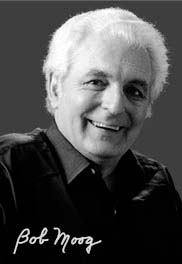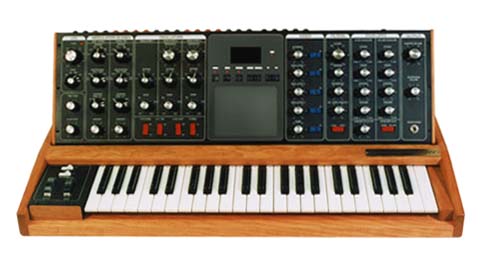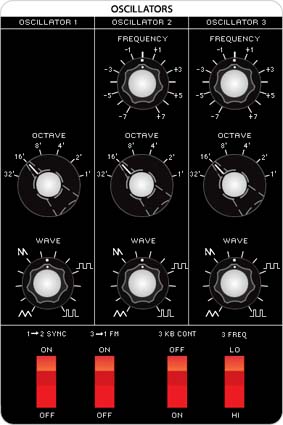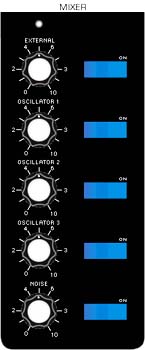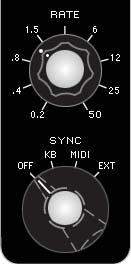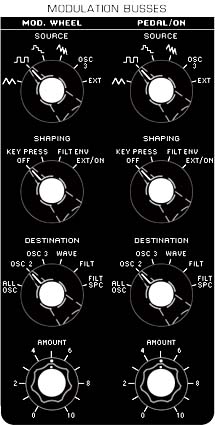FUTURE STYLE
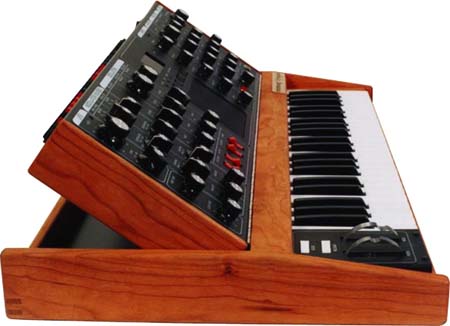 |
|
|
|
Minimoog Voyager synthesizer , produced in two editions, the Signature Edition and the Performer's Stage Edition. The function set and sound quality of the two editions are the same. The Signature Edition is being designed and built with the discriminating musician-collector in mind. Signature Edition instruments have these distinguishing features: Hand-finished cabinet in your choise of genuine solid maple (light), cherry (honey-colored), or walnut (brown). Illuminated, clear acrylic Pitch Bend and Modulation wheels Gold-plated nameplate Padded Gig Bag Four-year warranty, with two free factory tunings. A specific low serial number is assigned to each order. Every Signature Edition Instrument is individually inspected and signed by Bob Moog. The price of the Signature Edition Minimoog Voyager is US $2,995 and the orders received are scheduled to be filled during April, 2002. The MINIMOOG VOYAGER Synthesizer
Each of the three high-stability all-analog voltage-controlled OSCILLATORS has a six-position octave selector and a continuously variable waveform control. Four switches implement 'Hard Synch,' Linear Frequency Modulation, and Drone and Low Range settings. FREQUENCY controls (2) vary the frequencies of Oscillators 2 and 3 over a +/-7 semitone range with respect to Oscillator 1. OCTAVE selectors (3) set the frequency ranges of the oscillators in six octave steps. WAVE controls (3) provide continuous control over the waveforms of the oscillators, from triangular, to sawtooth, to square, to narrow rectangular. 1-2 SYNC switch synchronizes the Oscillator 2 waveform to the frequency of Oscillator1, for dramatic timbral effects. 3-1 FM switch provides linear frequency modulation of Oscillator 1 by Oscillator 3. 3 KB CONT switch disconnects Oscillator 3 from control by the keyboard, thereby enabling it to function as a drone. 3 FREQ switch lowers the frequency of Oscillator 3 into the sub-audio range, thereby enabling it to function as a low frequency audio or modulating oscillator. Mixer Module Five-input mixer for combining the audio sources prior to filtering. Input Level controls (5) adjust the relative levels of the oscillator, noise, and external audio input signals. Input switches (5) enable the player to quickly switch individual audio signals in and out. External Level LED enables the player to set the correct external audio signal level. Two "Moog-style" lowpass-resonant filters with choice of two-pole or four-pole response. CUTOFF control sweeps the frequencies of both filters throughout the audio range. SPACING control sets the spacing between the frequencies of the two filters, over a +/-3 octave range. RESONANCE control adjusts the resonance of both filters, from none (pure lowpass response) to filter oscillation. KB CONT AMOUNT control sets how much the filters open and close as the player presses different keys on the keyboard. 2-POLE 4-POLE switch selects between two-pole and four-pole response for both filters. The Envelopes Module generates two wide-range ADSR (Attack Decay Sustain Release) envelopes. The Filter Envelope sweeps the filter and is available for modulation shaping. The Volume Envelope shapes the overall volume. ATTACK controls (2) determine the attack times of the envelopes. DECAY controls (2) determine the decay time constants of the envelopes. SUSTAIN controls (2) determine the sustain levels of the envelopes. RELEASE controls (2) determine the release time constants of the envelopes. AMOUNT TO FILTER control determines how much the filter envelope will open and close the filter, from full negative (inverted envelope) to full positive (non-inverted envelope). ENVELOPE GATE SWITCH selects whether the envelopes will be triggered by the keyboard, or by an externally-applied gate. The wide-range LFO produces triangle, square, Sample and Hold, and Smoothed Sample and Hold waveforms. Waveforms can be synched from the keyboard, MIDI, or an external foot switch or gate. Low Frequency Oscillator generates triangular, square, Sample & Hold, and smoothed Sample & Hold waveforms for use as modulating signals. RATE control sets the LFO rate over the range 0.2 Hz (one cycle every five seconds) to 50 Hz (fifty times a second). SYNC selector selects LFO synchronization source to be from the keyboard gate, MIDI, external gate, or off (no synchronization). RATE LED provides visual indication of the LFO rate. Selects the sources, destinations, and shaping signals for the MOD WHEEL bus and the EXT PEDAL bus. SOURCE selectors (2) selects the modulation source from the four LFO waveforms, Oscillator 3, or the external modulation input. DESTINATION selectors (2) selects the modulation destination from all the audio oscillators, just Oscillator 2, just Oscillator 3, the oscillator waveforms, the filter frequencies, or the filter spacing. SHAPING selectors (2) selects the key pressure signal, filter envelope, or the signal at the Modulation Shaping jack to shape the modulation signal on that bus. AMOUNT controls (2) sets the overall modulation amount for each bus. Output Module MASTER VOLUME control sets the overall level of the instrument's audio output. HEADPHONE VOLUME control sets the overall level of the headphone output. HEADPHONES jack: 1/4" tip-ring-sleeve phone jack for regular headphones.
Glide and Fine Tune Module GLIDE varies the speed at which the keyboard voltage changes, from instantaneous to several seconds. FINE TUNE adjusts the overall tuning of the instrument.
MIDI Implementation Capabilities FRONT PANEL STORAGE AND RECALL: Except for the Headphone Volume control and the Fine Tuning control, the settings of all front panel controls, selectors, and switches are stored in the nonvolatile digital memory. A total of one hundred front panel programs may be stored for instant recall. CONTROL OF FRONT PANEL PARAMETERS THROUGH MIDI: All front panel parameters are controllable through MIDI Control Change commands. TRANSMISSION OF FRONT PANEL SETTING VIA MIDI: Setting of all panel controls, selectors, and switches may be transmitted via MIDI Control Change Commands. TRANSMISSION AND RECEPTION OF KEYBOARD DATA VIA MIDI: Polyphonic note-on and note-off with velocity can be transmitted. Channel afterpressure can be transmitted. Pitch Bend and Modulation (from the wheels) can be transmitted. All these can also be received, although the tone generators will respond to only one note-on message at time. UPLOADING AND DOWNLOADING OF BANKS OF SETTINGS VIA MIDI: Individual panel programs, or entire banks, may be uploaded and downloaded via MIDI. UPDATING OF OPERATING SOFTWARE VIA MIDI: The instrument's operating software can be updated via MIDI files . 44 KEY KEYBOARD produces Pitch, Gate, Velocity, and Pressure control outputs. WHEELS: Pitch Wheel bends pitch over a range of up to +/-1 octave. Mod wheel controls the gain of the MOD WHEEL bus. GLIDE and RELEASE switches provide real-time on-off control over the glide and release functions. At the center of the Voyager panel is a Tactex three-dimensional touch surface, for imparting multidimensional expressive gestures to the performance. TACTEX TOUCH SURFACE provides three continuously-variable control signals which are derived from the up-down and left-right position of the player's finger, and the force with which the player pushes on the surface. PEDAL/CONTROL INPUTS. The nine jacks are specially labeled with black letters on a white background. They accept either expression pedals or control voltages, and control the following performance parameters: LFO RATE, MODULATION SHAPING CONTROL , MODULATION SOURCE CONTROL , OSCILLATOR PITCH , OSCILLATOR WAVE , FILTER CUTOFF , FILTER SPACING , FILTER RESONANCE , ENVELOPES RATE CONTROL OUTPUTS. The five jacks deliver control signals which can be further processed or used with other voltage-controlled equipment.
LFO SYNC. A gate or trigger applied to this input will reset the LFO waveform to the beginning of its cycle. ENVELOPES GATE. A gate applied to this input will start the envelopes. KEYBOARD GATE. A gate signal is produced at this jack whenever a keyboard key is depressed. MIXER EXT IN. Plug any instrument-level or line-level audio signal in this jack to combine with the oscillator and noise signals prior to filtering. GLIDE and RELEASE. A foot switch plugged into either of these jacks will have the same effect as depressing the corresponding switch on the left hand controller panel. MIX OUT. The output of the audio mixer appears here, before being fed to the filter. FILTER AUDIO IN. Normally, the Mixer output is bridged directly to this jack. If you plug something into this jack, that breaks the normal connection. In conjunction with the MIX OUT jack, this jack can be used as an effects loop for external processing of the Mix before it goes to the filter. AUDIO OUT. This is the main audio output. It is a balanced output for noise-free performance on stage or in the studio. MIDI: MIDI IN, THRU, and OUT connectors. 100-240 VOLT POWER CONNECTOR enables the Minimoog Voyager to be plugged in anywhere in the world without special switching or adapters. |
|
info |
Italy: MIDIWARE Srl. - Phone: (++39) 06 3036 345
Australia - Victoria- Hawthorn - Awave Productions - Phone: 613 9819 4603
Belgium - Netherlands -Luxembourg: AMPTEC - Phone: 32-011-28-14-58 Email
Denmark - Sweden - Norway - Finland: Elmelid Musik - Phone: 46 (0) 413 55 99 33 Email
UK: Turnkey/Soho Soundhouse - Phone: 44 207 419 9999 FAX: 44 207 379 0093
France: M.E.S.I. - Phone: 331 4005 1718 FAX: 331 4005 0011
Germany: EMC - Phone: 49 7345 238141 0 Email
Iceland: Sampil-Notan - Phone: 354 595 1960 Fax: 354 595 1961
Spain: Ventamatic - Phone: 34 93 363 7100 e-mail
Japan: Moridaira Musical Instrument - Phone: 81-3-3862-1641 Fax: 81-3-3864-7454
Korea: MIDIstation - Phone: 82-2-747-8285 e-mail
 advanced technologic sound magazine 2002 issue 102
|
